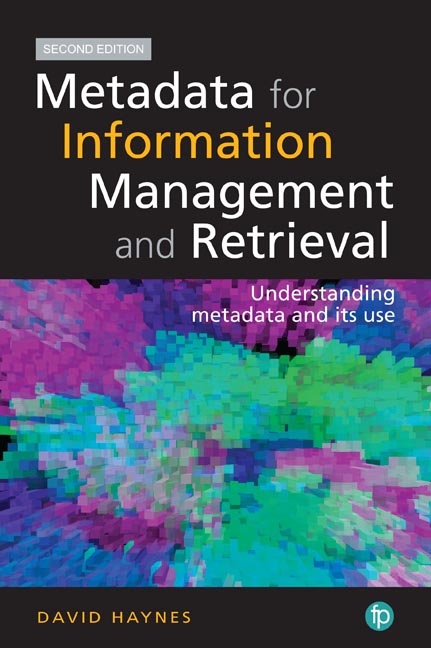Book contents
- Frontmatter
- Contents
- List of figures and tables
- Preface
- Acknowledgements
- PART I METADATA CONCEPTS
- PART II PURPOSES OF METADATA
- 5 Resource identification and description (Purpose 1)
- 6 Retrieving information (Purpose 2)
- 7 Managing information resources (Purpose 3)
- 8 Managing intellectual property rights (Purpose 4)
- 9 Supporting e-commerce and e-government (Purpose 5)
- 10 Information governance (Purpose 6)
- PART III MANAGING METADATA
- References
- Index
8 - Managing intellectual property rights (Purpose 4)
from PART II - PURPOSES OF METADATA
Published online by Cambridge University Press: 08 June 2018
- Frontmatter
- Contents
- List of figures and tables
- Preface
- Acknowledgements
- PART I METADATA CONCEPTS
- PART II PURPOSES OF METADATA
- 5 Resource identification and description (Purpose 1)
- 6 Retrieving information (Purpose 2)
- 7 Managing information resources (Purpose 3)
- 8 Managing intellectual property rights (Purpose 4)
- 9 Supporting e-commerce and e-government (Purpose 5)
- 10 Information governance (Purpose 6)
- PART III MANAGING METADATA
- References
- Index
Summary
Overview
This chapter considers the ways in which metadata has an impact on intellectual property rights and information access rights. It goes on to describe the issues arising from authenticity, ownership, and rights management. A discussion of different models of intellectual property (IP) rights considers the Open Digital Rights Language as an example of an information modelling language that deals with intellectual property rights. The indecs system and PREMIS are referred to, because they both deal with rights, although they are discussed in more detail elsewhere. There is also a brief discussion of the way rights are handled by Dublin Core, MPEG-21 and the METS Rights extension to METS. The chapter goes on to consider provenance, starting with a general definition and then describing the PROV metadata standard. It then considers provenance in the context of records management, e-documents, books and printed materials.
Rights management
Protection of intellectual property rights has a major economic impact on many industries. One of the drivers for the development of metadata standards in the publishing and book industry has been the need to manage copyright effectively. They form a key part of the framework for publishing, while protecting the rights of those involved in creating, performing or distributing a creative work. In most countries an author has moral rights to be identified as the creator of a work and consequently to enjoy the benefits that come with these rights. The World Intellectual Property Organization (WIPO) in Geneva regulates international treaties to help facilitate international exchange and trade in intellectual property (WIPO, 2015). The interests of different parties involved in intellectual property protection are sometimes in conflict and use of the appropriate metadata helps to identify those interests. Metadata provides a way of mapping the interactions between the stakeholders and provides a mechanism for addressing rights and ownership issues. The ease of copying and faithfulness of reproduction of digital resources both pose an enormous challenge to publishers, record producers and film makers. The growth of peer-to-peer servers for filesharing services continues to be a threat to copyright holders, because of the way they bypass royalty payments.
Information
- Type
- Chapter
- Information
- Metadata for Information Management and RetrievalUnderstanding metadata and its use, pp. 127 - 138Publisher: FacetPrint publication year: 2018
